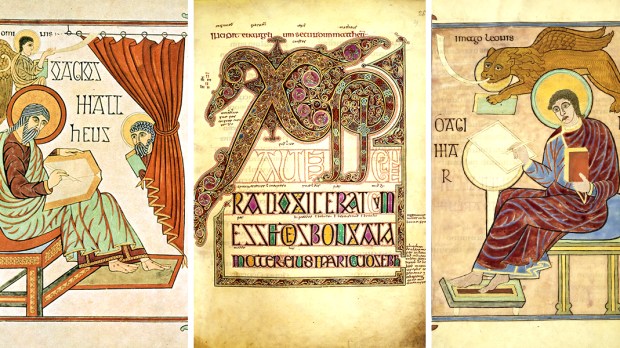Fantastic beasts. Glorious greenery. Elaborate initials framing miniature scenes from the Bible or legend. The power of the word brought to life, painstakingly, in careful script and gorgeous inks made from powdered gems and pure gold leaf. The illuminated manuscript has fascinated book lovers and art fans, secular and religious, from the earliest days when scribes put quills to parchment. One of the richest manuscript collections in the world, that of the British Museum, is now digitized and available to everyone at the click of a mouse.
It was Erwin Panofsky, in his Renaissance and Renascences in Western Art, who explained the Italian Renaissance was preceded by at least two major revivals of Greek and Roman antiquity, one of them being the 9th-century Carolingian, which Panofsky understood as a revival of classical forms that influenced styles of lettering and decoration. (The later literary revival of the 12th century, Panofsky explained, was a revival of classical content.) But when the British Museum was founded in 1753, its extraordinary manuscript collections included pieces not only from the Carolingian revival Panofsky was so fond of, but even the famous Lindisfarne Gospels, written and illuminated in the early 8th century.
The Illuminated Manuscripts Catalogue of the British Library includes three major collections. One, gathering the manuscripts of Sir Robert Cotton (1571-1631) which were left to England by his grandson Sir John Cotton in 1702, is known as the Cotton Collection and includes the largest gathering of Anglo-Saxon manuscripts in the world.
Sir Hans Sloane (1660-1753) was the physician, scientist and collector who willed his vast collection of plants, animals, antiquities and books and manuscripts to England in 1753, forming the foundation of the British Museum. His Sloane Collection contains a 14th-century illuminated surgical textbook, among numerous early medical works.
Last, but not least, the Harley Collection, manuscripts gathered by Robert Harley (1661-1724) and Edward Harley (1689-1741), 1st and 2nd Earls of Oxford, and sold to the Museum by the Countess of Oxford and her daughter, the Duchess of Portland, includes numerous religious and literary treasures such as the 12th-century Worms Bible, the Harley Romance of the Rose, and the Psalter of Queen Philippa of England.
These unique jewels, and many more, are yours to enjoy (and download) by clicking here.

